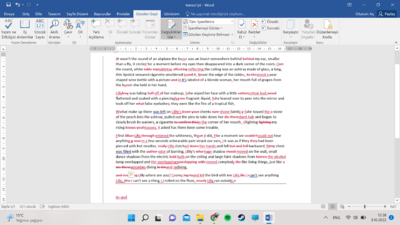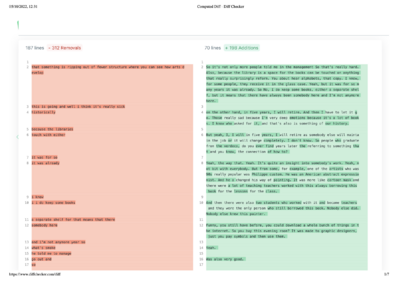User:Bnstlv/transclusion-cards: Difference between revisions
| Line 24: | Line 24: | ||
We assumed they had a common source, something transcluded in both of them (we assumed this because we knew they were sourced from the same audio recording). We selected a short section of each that seemed to be the same point and compared them on https://www.diffchecker.com. | We assumed they had a common source, something transcluded in both of them (we assumed this because we knew they were sourced from the same audio recording). We selected a short section of each that seemed to be the same point and compared them on https://www.diffchecker.com. | ||
[[File:Diff-check-step1.png|thumb| | [[File:Diff-check-step1.png|thumb|side-by-side text comparison. left side - vosk. right side - phone|center|400x400px]] | ||
Then we emphasised the identical (transcluded) elements. We inspected the code (different classes) to find out how the identical parts were shown on the screen. When we found them we tweaked the css values (rules) to change the appearance of the text. Basically, we blacked out the appearance of the non-identical parts (we hid them) and thus highlighted the identical ones. | Then we emphasised the identical (transcluded) elements. We inspected the code (different classes) to find out how the identical parts were shown on the screen. When we found them we tweaked the css values (rules) to change the appearance of the text. Basically, we blacked out the appearance of the non-identical parts (we hid them) and thus highlighted the identical ones. | ||
Revision as of 07:37, 10 October 2022
Making cards: transcluding
https://pad.xpub.nl/p/Methods5Oct22
Project description
- Team Stephen - Boyana
- The Why-How-What model
On Monday, October 3, we all gathered at the Research station to meet Wilma. Wilma is an ex-librarian, now the research station master. We listened to her story and recorded it on Boyana's phone. Our assignment by Simon and Steve was to edit the vosk-transcribed text to make it legible to an uninitiated reader. In groups of two people, we had to make the recording legible as text ("cards").
What (object of research) Community diff check. Based on human software interactions.
- cards visual translation of a process...result of the experiment; - which visualises the process; creates a key and accesses the full information.
We saved it in a pdf format (web to print). PDF is a good format for documents because it is portable.
How (methodology) - we started with two computer-transcribed texts, one we made in vosk and another by using the automatic software (app) on Boyana's phone.
We assumed they had a common source, something transcluded in both of them (we assumed this because we knew they were sourced from the same audio recording). We selected a short section of each that seemed to be the same point and compared them on https://www.diffchecker.com.
Then we emphasised the identical (transcluded) elements. We inspected the code (different classes) to find out how the identical parts were shown on the screen. When we found them we tweaked the css values (rules) to change the appearance of the text. Basically, we blacked out the appearance of the non-identical parts (we hid them) and thus highlighted the identical ones.
We also planned to make the remaining text more legible by formatting, adding punctuation, shortening, and possibly adding words. Our plan was to reveal(?) the source text by editing in this way.
Why (motivation-research question) - By doing so (the editing) we'll be adding meaning to the text so it forms the story about Wilma. Because the source of the text is actually her life story. We consider her as a co-author of the text. We also want to keep a trace of the missing character of Wilma.
We wanted to explore software - human interaction, how humans and algorithms can interact to create stories. Conversation (with Wilma, with recording devices, with eachother, with diff checker) We made the decisions what this piece of software should do with the text. We made an interpretation of the digital output into the physical space by arranging furniture and connectors.
why)


